From art to artificial reefs
Interview with
To visit Jason de Caires Taylor's artwork you have a pay a visit a very unconventional gallery. Installed on the seabed in various locations around the world, his sculptures take on a life of their own as they become engulfed in marine organisms and form artificial reefs that spread a message about people and the oceans.
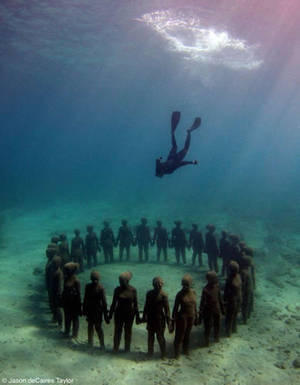 Jason - Well first of all I create artificial reefs but using sculptures. And the main aim of them really is not only an art project but also a conservation project. All of the sculptures go on to create reefs which not only aggregate fish and promote corals but they also diverts tourists away from natural reefs which leaves them time to regenerate on their own accord.
Jason - Well first of all I create artificial reefs but using sculptures. And the main aim of them really is not only an art project but also a conservation project. All of the sculptures go on to create reefs which not only aggregate fish and promote corals but they also diverts tourists away from natural reefs which leaves them time to regenerate on their own accord.
I hope to use the sculptures as a way to symbolise us living in a symbiotic relationship with nature not just us always working against it.
Just the image of a human figure ingrained with marine life is affording it a certain type of respect. I really am worried about the state of our oceans and how they're changing so dramatically and I'm trying to use the work to highlight some of these issues.
Helen - So, people visiting your work obviously have a very different perspective to visitors at a regular art gallery. The light changes, people can hover over your work, or swim alongside it. Do you see that as a challenge or as an opportunity?
Jason - Both really. It's definitely a new way to look at art. There's so many different perspectives and it's such a new world down there. Each visit is never quite the same. So I have people that go one day and it's overcast and stormy and the works take on a certain meaning. And then they go another day and it's light and euphoric and it's a completely different experience.
So I actually think it adds to the work.
Helen - How do you choose who you're going to make these sculptures out of? And do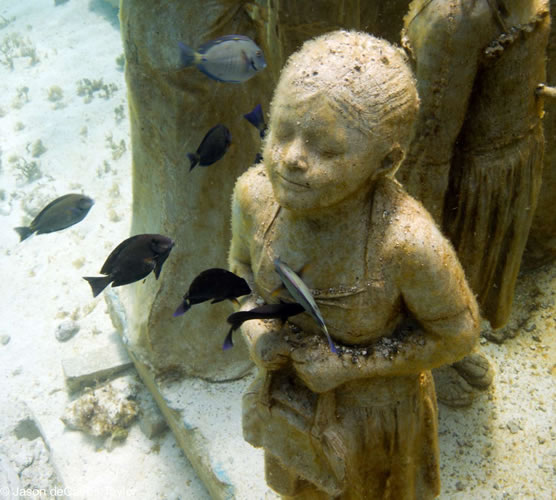 you get a lot of volunteers? It sounds like it's quite a messy business.
you get a lot of volunteers? It sounds like it's quite a messy business.
Jason - Mainly with the Silent Evolution I was looking for a cross section of society, so I was aiming to get people from different communities, different ages, male and female, different age groups. So I was constantly on the look out for people just in every day life. And if I saw someone that had particular characteristics or fitted any of the profiles then I'd approach them and ask them to see if they wanted to participate.
I'd bring them down to my studio then it's a case of them getting undressed to their underwear, getting covered in Vaseline then applied with all these very messy materials, alginate and plaster. And it's quite a long process. From there we make a plaster original, then we make a silicon mould, then finally it's a cement piece.
Helen - And how do people respond when they see themselves cast in cement? And do any of them go and visit their own sculpture installed on the seabed?
Jason - Yes, a few people have gone to visit it. It's actually interesting because obviously people change. Some of the children I've done are now much taller than they were a year ago. One woman was pregnant, she's had her kid. Actually one of the models died a few months ago, so it really did cover the whole circle of life.
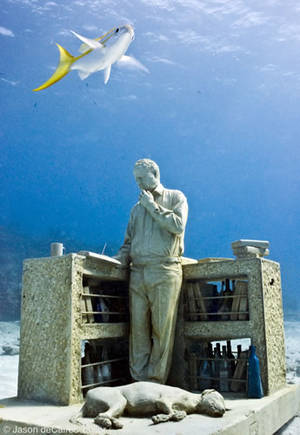 Helen - And you talk about the people change, but your sculptures change too don't they? In a way you're sort of giving them over to the sea and to sealife. How does that feel? Does it feel like they're not yours anymore?
Helen - And you talk about the people change, but your sculptures change too don't they? In a way you're sort of giving them over to the sea and to sealife. How does that feel? Does it feel like they're not yours anymore?
Jason - I personally find it the most exciting and dynamic part of the work. It's so unpredictable. I went recently and the hair of one of the sculptures has started growing this sort of curly algae and I couldn't ever had predicted that would colonise that particular part. But it just looks so perfect in its spot.
I almost feel some days that I'm cheating in some ways as a sculptor because I never actually finish the work, it's like another shift of artists comes along and adds the finishing touches.
Helen - And do you ever feel tempted to say, oh no I don't want that bit there, and do you ever feel like you want to interfere with what nature is doing to your work?
Jason - Sometimes, sometimes. I've done a new piece which has a false lung inside it and I'm trying to keep that lung clear so that air can be exhaled out of the sculpture. So I'm actually trying to stop the growth on that part and it's actally very difficult to do.
I did a piece past year that's called Man on Fire and on that one I planted a particular 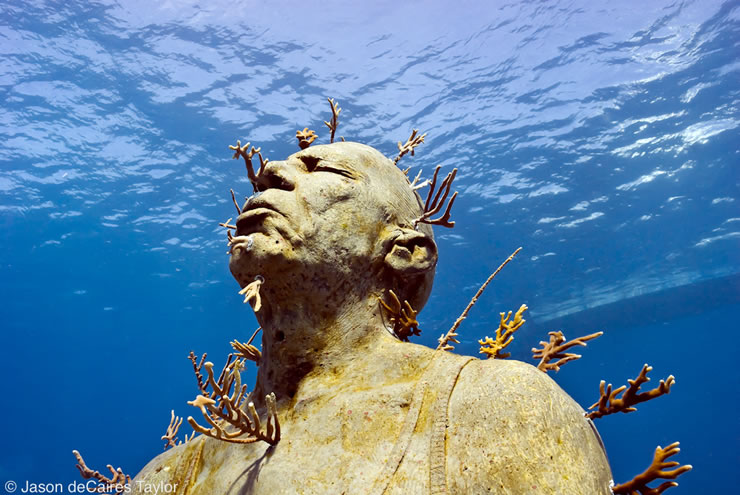 species of fire coral and the aim was that he was going to turn completely yellow over time and look like he's on fire. But what happened is another algae has attached onto it and it's having a little war with the fire coral. So I think I'm going to have to send some more fire coral troops in to win that war for it to complete its objective.
species of fire coral and the aim was that he was going to turn completely yellow over time and look like he's on fire. But what happened is another algae has attached onto it and it's having a little war with the fire coral. So I think I'm going to have to send some more fire coral troops in to win that war for it to complete its objective.
Helen - What sort of other creatures are colonising your work? What else are you seeing turning up?
Jason - There's masses of little relationships going on. We have lots of lobsters that colonise underneath all the gaps in the sculptures. We have these very territorial fish called damselfish and they claim a little patch of the sculpture and they rigorously defend it, so whenever I go to take photographs these fish come and bite me on the hands because I'm invading their area, which is interesting.
There recent installation which I've just finished in Cancun is this mass gathering of 400 people, and it's actually designed so that it creates all this void area beneath the peoples' feet and that's what fish love to take refuge. It's been there 6 months now and I went back last week and there's literally thousands of fish that have colonised there already and it's really exciting to see.
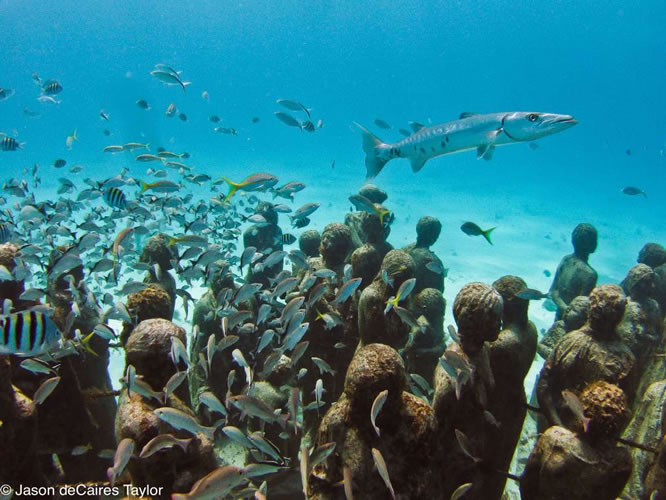 You can actually see the dynamics because predator species like the barracuda hover around the top of it and the big schools of fish duck and weave in between the legs to avoid being eaten. It's really fascinating.
You can actually see the dynamics because predator species like the barracuda hover around the top of it and the big schools of fish duck and weave in between the legs to avoid being eaten. It's really fascinating.
Helen - On a practical note, how to you make sure your work doesn't get broken up and swept away by currents? You've got the ocean to deal with, how do you make your sculptures last in that sense?
Jason - That's probably the number one biggest challenge is protecting the works especially where I'm working at the moment in Cancun because it's so prone to hurricanes. A lot of research and a lot of design has gone into dealing with that.
At the moment all the sculptures are incredibly heavy. The recent ones of the Silent Evolution were put down in units and they were 5 tonnes each unit. And then those are drilled into the sea floor.
Working underwater I can't use any metals and 90% of public sculpture uses metal. So it's been quite difficult finding alternatives.
Helen - Presumably you can't use metals because that would just rust away?
Jason - Yes, they start rusting and degrading. The sculptures have to be there for a very long time to establish slow-growing hard coral. So it's vital that they remain intact.
Helen - What's next for your underwater work?
Jason - I'm continuing in Mexico. I'm exploring a whole new series of pieces which are going to be kinetic. So they're going to be moving underwater with the currents. But it's actually going to be using gorgonian fan coral. There's a lot of it around here and it's quite often damaged by storms or strong weather. So we find a lot of it dislodged and we're using those dislodged pieces to attach to the sculpture so it'll have wings that move underwater. So it'll be very interesting to see how it works out.
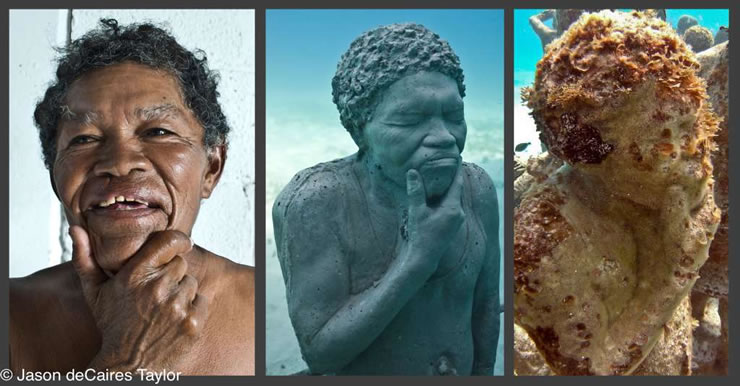 Find out more
Find out more
Underwater Sculpture by Jason deCaires Taylor









Comments
Add a comment